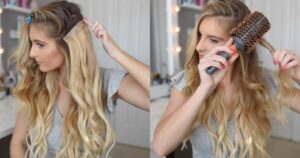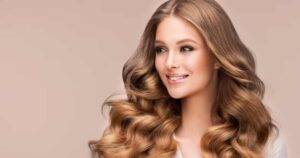A haircut is the act of trimming or shaping hair to achieve a desired style or length and the hair color refers to the natural or artificially applied pigmentation of human hair, determining its appearance and hue.
When it comes to hair transformations, the age-old question persists: Do you cut or color your hair first? It’s a dilemma that many salon-goers face, and the answer often depends on your desired end result and the expertise of your stylist. Let’s explore the factors that influence this crucial decision.
When getting a haircut and color treatment at a salon, it’s common to cut the hair first. Cutting before coloring allows the stylist to create the desired shape and style. Coloring is typically done afterward to avoid trimming off newly colored strands and to ensure a polished, cohesive look.
Is it better to get your haircut before or after coloring?
Getting your haircut before or after coloring depends on your preference and the results you want. If you get your haircut before coloring, the stylist can work with your hair’s natural length and texture, ensuring that the color looks even and seamless.
Getting a haircut after coloring can help refine the shape and style, making your new color pop and giving you a fresh look. It’s essential to discuss your desired outcome with your stylist or brand developer to decide what works best for you.
When should I dye my hair after cutting it?
You can dye your hair after cutting it, but it’s generally recommended to wait a few days. This allows your hair and scalp some time to recover from the cutting process.
Dyeing your hair immediately after a haircut might be a bit harsh on your hair and scalp, potentially causing irritation or uneven color results. Waiting a few days will give your hair a chance to settle, making it a better canvas for your new hair color.
How long should I wait after cutting my hair to dye it?
After cutting your hair, it’s a good idea to wait a little before dyeing it. The exact time you should wait can depend on your hair type and the products you plan to use.
It’s recommended to wait at least a week or two to let your hair recover and heal from the haircut. This allows your hair to regain its natural oils and moisture, which can help the dye adhere better and result in a more even color.
Comparison of Cut First vs. Color First
| Aspect | Cut First | Color First |
| Advantages | – Ensures an even and precise cut | – Enhanced color application |
| – Improved access for color application | – Easier assessment of color outcome | |
| Disadvantages | – Risk of color bleeding during the cut | – Potential need for additional touch-up cuts |
| – Difficulty in visualizing the final color result | – Risk of color staining on recently cut ends |
Haircut and color same day
Getting a haircut and changing your hair color on the same day is a great way to refresh your look. It’s like giving your hair a double makeover in one go! When you combine a fresh haircut with a new hair color, you can achieve a stunning and complete transformation.
Whether you’re going for a subtle change or a bold new style, doing both on the same day is a convenient way to enhance your appearance and boost your confidence.
Cut or color first short hair

When it comes to short hair, deciding whether to cut or color first is a common dilemma. The choice usually depends on your specific preferences and needs. If you want a significant change in both your haircut and hair color, it’s often recommended to start with the cut.
Once the haircut is done, you can then proceed to color your hair to complement the new style. However, if you’re only making minor adjustments to your existing short hairstyle, you can opt for coloring first, especially if the color change is your primary goal.
Why do hairdressers dye hair before cutting?
Hairdressers often dye hair before cutting it for several reasons. Firstly, coloring the hair before cutting allows the hairdresser to see the final look and make precise adjustments to the haircut to complement the new color.
This ensures that the haircut and the hair color work together harmoniously, resulting in a more polished and cohesive appearance. Dyeing the hair first can also help hide any imperfections or unevenness in the haircut, making it easier for the hairdresser to create a flawless and even style.
Frequently Asked Questions
Should I always cut my hair before coloring it?
Not necessarily. The choice between cutting or coloring first depends on various factors, including your hair’s current condition, your desired style, and your stylist’s recommendation.
Can I color my hair and then cut it later if needed?
Yes, you can color your hair first and then cut it later, but keep in mind that cutting first may provide a better canvas for color application. In some cases, you may need a touch-up cut after coloring.
Does the order matter for all hair types and styles?
No, the order may vary based on your specific hair type and style. It’s essential to consult with your stylist, as different hair textures, lengths, and desired colors may require different approaches.
What if I want highlights or balayage? Does the order change?
For highlighting or balayage, the choice often depends on the desired look. Typically, color is applied before cutting for these techniques to achieve a seamless blend and precise placement.
How can I ensure a successful outcome when deciding the order?
Effective communication with your stylist is crucial. Discuss your hair goals and expectations during the consultation. Trust their professional judgment, as they will recommend the best order based on your individual needs and preferences.
Conclusion
The choice between cutting or coloring hair first in a salon should be made based on individual client needs and preferences. There is no one-size-fits-all answer to this dilemma. By considering factors like the client’s goals, hair condition, and desired style, stylists can ensure the best possible outcome for their clients.
Flexibility and effective communication are key, allowing hair professionals to adapt their approach to deliver the desired results, reinforcing that there is no universally right or wrong way to tackle this question in the world of hairdressing.











